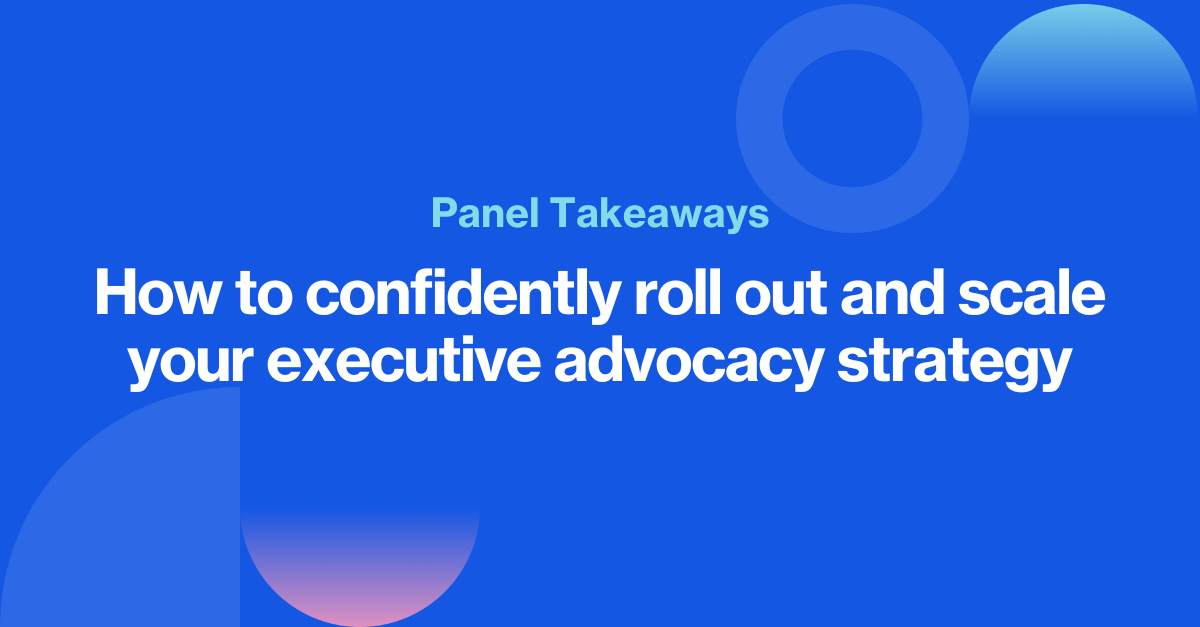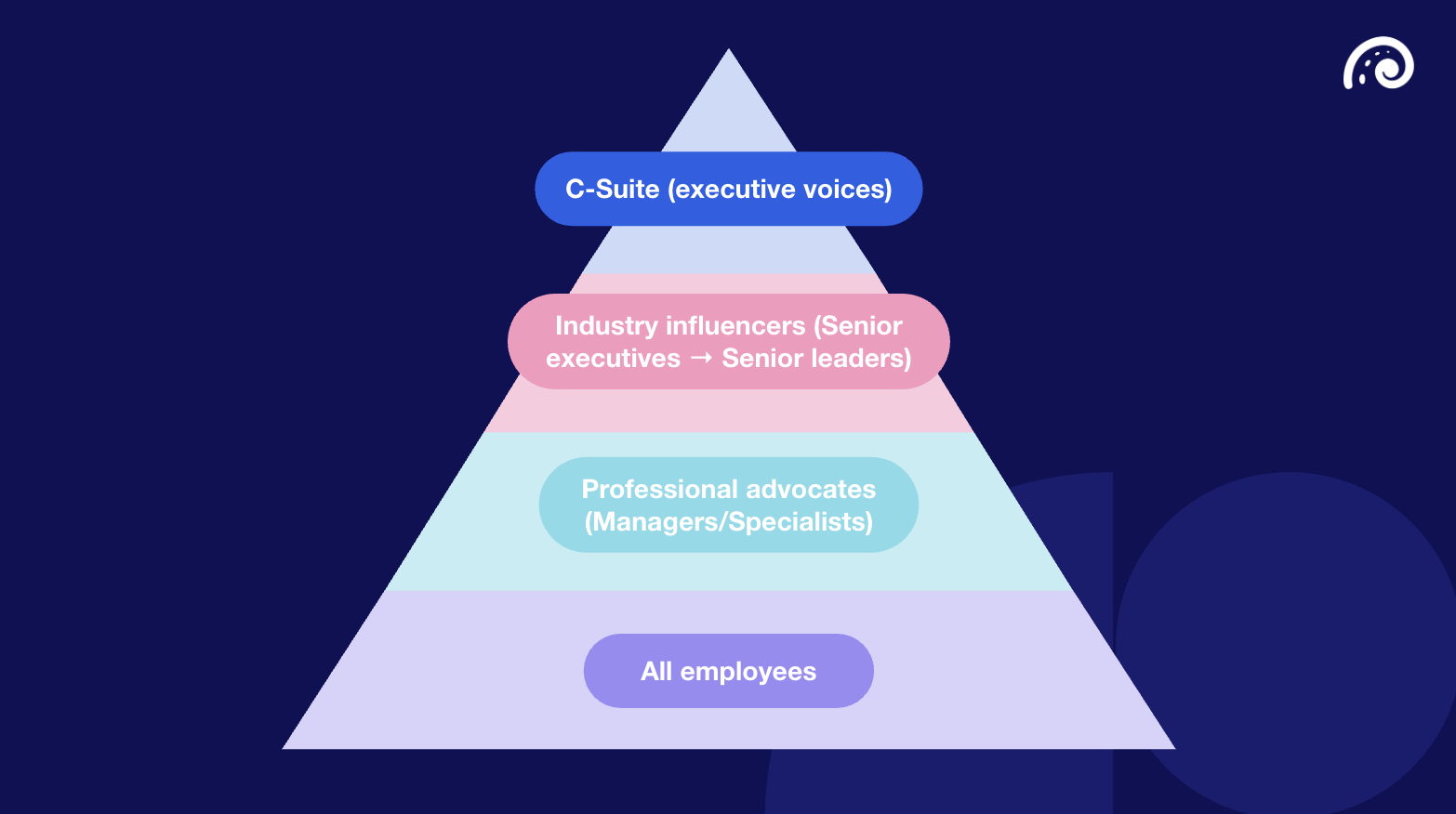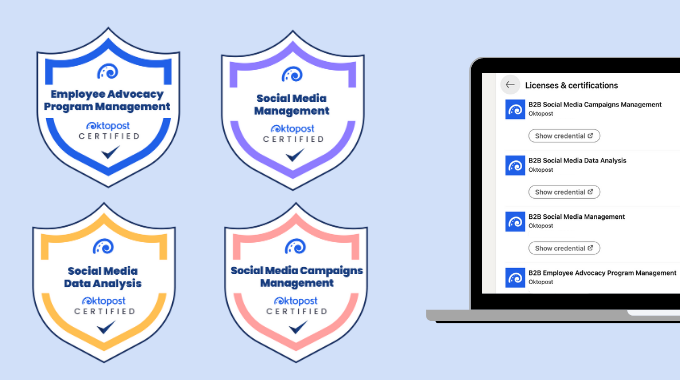Straight from your Rising Stars: 7 ways to confidently roll out and scale your executive advocacy strategy

Table of contents
- Executive advocacy: the secret weapon hiding in plain sight
- 1. Executive advocacy is the ultimate low effort, high ROI channel
- 2. Start small, educate widely, and model good behavior
- 3. Win leadership buy-in with ROI and a three-year maturity curve
- 4. Scale with a tiered pyramid model of advocates
- 5. Balancing AI with authenticity in executive advocacy
- 6. Create ripple effects that turn advocacy into culture
- 7. Report the right metrics, not vanity numbers
- Final advice from the experts
- Start building your executive advocacy strategy
Executive advocacy: the secret weapon hiding in plain sight
Your executives have the loudest voices in the room, if they choose to use them. In B2B, executive advocacy is one of the most cost-effective ways to build credibility, earn trust, and drive measurable pipeline. Yet many companies struggle to get leaders posting consistently.
That’s why we brought together two of your B2B Social’s Rising 30 stars who offer two different perspectives for a value-packed panel on executive advocacy:
- Jordan Tennenbaum, Head of Social Media at Talkdesk, who runs advocacy day-to-day as a one-person social team.
- Archana Dhankar, a seasoned B2B marketing leader, who has scaled advocacy from the top down across global organizations.
Together, they laid out how to launch, scale, and prove the value of executive advocacy. Here are the seven takeaways every social team needs to hear.
1. Executive advocacy is the ultimate low effort, high ROI channel
Jordan called executive advocacy “low effort, high ROI”, and for good reason. He’s seen executives spend minimal time on LinkedIn and spark conversations that influence pipeline.
Why it works:
- Trust: Posts from executives carry far more weight than branded content.
- Visibility: Leaders often have larger, more engaged networks in the exact ICP you’re targeting.
- Conversion: Jordan cited that leads influenced by social are seven times more likely to convert.
Archana added that executive advocacy is also about modeling. “When execs are active, employees get active too,” she said. In a reality where every company runs similar campaigns, authentic voices from leadership become the true differentiator.
2. Start small, educate widely, and model good behavior
When Jordan joined Talkdesk, he didn’t try to onboard hundreds of leaders at once. He started with what he had: an advocacy tool and a handful of willing executives.
His playbook:
- Learn the tool inside out: before pitching anyone else, make sure you know how to load, schedule, and support posts.
- Educate the company: Jordan ran presentations with different teams showing ROI stats, industry benchmarks, and why advocacy mattered.
- Use executive leadership enforcement: he asked executives to personally invite their teams to join. Employees are far more likely to say yes when the ask comes from the top.
- Model the behavior: Executives who post consistently set the tone for the rest of the organization.
3. Win leadership buy-in with ROI and a three-year maturity curve
Executives are busy, skeptical, and resource-conscious. They don’t just want to know that advocacy works, they want to see it can scale and sustain.
Jordan’s advice: speak the language leaders care about. Show ROI in terms of earned media value, pipeline influenced, and opportunities created. Use UTM tracking and CRM data to connect advocacy directly to revenue.
Archana added that you also need to paint a long-term picture. In the past, she built buy-in with a three-year maturity curve:
- Year 1: Pilot → onboard a small group of executives, prove early wins, and build confidence.
- Year 2: Scale → expand to senior leaders, introduce enablement, and standardize processes.
- Year 3: Optimize → localize by region, encourage more original thought leadership, and refine strategy based on learnings.
“Leaders want to know it’s not a one-off campaign,” she explained. “They want to see how the program grows with the company.”
4. Scale with a tiered pyramid model of advocates
Not every advocate should be supported the same way. To scale advocacy without burning out your team, Archana recommends structuring participation as a four-tier pyramid model:

- Tier 1: C-suite executives
- White-glove treatment with bespoke content, direct support, and careful coaching.
- Encourage them to balance company announcements with personal leadership reflections and industry POV.
- Tier 2: Industry influencers and senior leaders
- Provide tailored content and guidance, often supported by AI-assisted drafts.
- These leaders are closer to the industry conversation and benefit from tools that adapt content to their own tone and expertise.
- Tier 3: Professional advocates (managers and specialists)
- Offer more self-service content plus light enablement.
- Provide prompts, suggested posts, and training so they can confidently share without heavy reliance on the social team.
- Tier 4: Employees
- Share culture, HR, and lighter brand content to keep their networks engaged.
This approach ensures executives get the support they need while empowering the wider organization to participate at scale.
5. Balancing AI with authenticity in executive advocacy
No conversation about modern advocacy is complete without AI. Both experts agreed it can make programs faster and more scalable, but it comes with clear caveats.
Jordan described AI as “the best thing since sliced bread” for social teams. He sees it as a way to boost efficiency, cover more ground, and help executives share content more consistently. For him, AI is a productivity gain that can lighten the load for lean social teams.
Archana welcomed AI too, but with caution. She emphasized that while AI can summarize a white paper or draft a post, it cannot supply the opinion that makes executive content authentic. Leaders still need to add their personal perspective, because audiences can quickly spot a post that feels generic or AI-generated.
Both agreed that the balance is key: AI can support productivity, but authenticity must come from the executive. The human voice, pride in a milestone, a reflection on industry changes, or a unique perspective, is what builds trust and credibility.
6. Create ripple effects that turn advocacy into culture
Advocacy isn’t just a marketing tactic, it can change company culture.
Jordan explained that when executives consistently post, employees take notice. They start to share, engage, and grow their own personal brands.
The ripple effect: more employees see the value of being active on LinkedIn and start to participate, and for marketing teams, this means more reach, engagement, and influenced pipeline grow in parallel.
This cycle also creates leverage for the social team. With results in hand, you can ask for more budget, resources, or seats in your advocacy platform.
7. Report the right metrics, not vanity numbers
Both experts agreed: reporting is where most advocacy programs sink or swim.
Archana said she wants to see results at least quarterly, but vanity metrics don’t move her. “Likes and shares are good, but I want to know if we’re reaching the right audience, the right job titles, the right regions,” she explained.
Her checklist for reporting that earns leadership trust:
- Audience quality: are new followers in your ICP?
- Influence on pipeline: track advocacy-driven traffic and opportunities.
- Consistency over time: show how executive participation sustains results, not just one-off spikes.
The golden rule: always tie social results back to business outcomes.
Final advice from the experts
Jordan’s closing message was for practitioners:
- Give yourself grace, you can’t do everything as a one-person social team.
- Keep advocacy fun, engaging, and authentic.
- Always prove ROI, numbers are your ticket to credibility and resources.
Archana’s advice was for leaders: be bold. “B2B social teams are often afraid to experiment. Borrow from B2C, tailor it for your brand, and stand out.”
Start building your executive advocacy strategy
Executive advocacy isn’t just another marketing tactic, it’s a strategy that drives credibility, builds trust, and influences revenue. With leadership buy-in, the right structures, and a balance of AI efficiency and authentic human voice, you can scale it across your organization with confidence.
At Oktopost, we help B2B brands roll out advocacy programs that stick, from executive support to employee activation. Want to see how it works? Let’s talk, we’d love to help.
Download and share with your team
Straight from your Rising Stars: 7 ways to confidently roll out and scale your executive advocacy strategy



